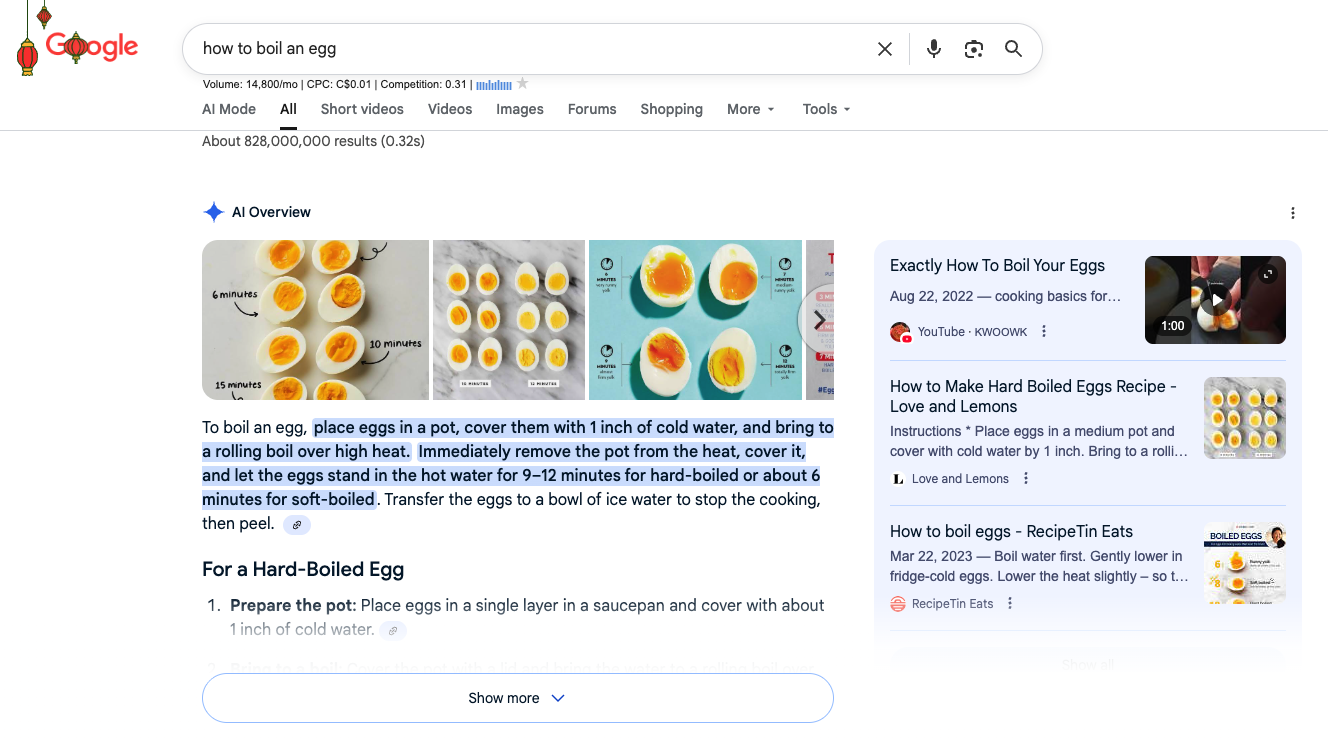Why is AI Overview a good thing?
Let’s be honest—when you just want a quick answer, it’s a game-changer. I personally love it. Less to read, fewer clicks, and no need to wade through junk sites filled with spammy AdSense traps. My user experience? Way better.
That said, history tells us it’s only a matter of time before black-hat SEOs start trying to game the system. They’ve done it with every major algorithm update, and AI Overview is just another upgrade they’ll try to pollute.
The good news? This time, it might be much harder to crack.
What is Google AI Overview—and why should you care?
You search Google. One quick question. And boom—the answer’s right there at the top. No ads. No fluff. No click-through. That’s Google AI Overview.
Fast, smart, and built for your question
This isn’t your typical search result. It’s a quick, smart summary pulled from top-quality content across the web, showing you exactly what you need to know—instantly.
Gone are the days of wading through someone’s life story before finding out how long to boil an egg. This is search, evolved. And it’s growing—AI Overviews now appear in 13% of all Google searches, doubling in visibility over the last two months.
 What’s the difference between AI Overview and AI Mode?
What’s the difference between AI Overview and AI Mode?
- AI Overview gives you a short, direct summary right in your search results.
- AI Mode is Google’s answer to ChatGPT. It turns your search into a full conversation.
Example use case
Instead of typing “best sushi in Toronto,” imagine asking, “Where can I get late-night sushi that’s open now?” and getting a personalised, conversational reply.
AI Mode is already being tested in the U.S. through Local Guides and will soon be available in Canadian Maps.
Who should be paying attention to this?
If you’re a business owner, marketer, or SEO pro, this change hits home. Especially if you’re newer to the field, trained on click-bait strategies—those rules? They’re fading fast.
Real talk
A bunch of my friends think we’re all going to lose our jobs and be replaced by AI… I laughed so hard when I heard that and simply said, “a weapon is only as dangerous as the hand that wields it.”
If, like me, you’ve leaned into long-tail keywords, human-first writing, and content that actually helps… you’re going to see old SEO projects that fell down the SERPs come back with a vengeance. I say this because it’s happening to me right now. So relax—you’re not falling behind. You’re good.
Google AI Overview isn’t killing SEO. It’s pushing it to evolve—into something called Generative Engine Optimization (GEO).
Where is SEO going? Welcome to GEO.
GEO may be the future. And it rewards exactly what good content has always been about:
- Speaking like a human
- Solving real problems
- Answering with clarity and structure
GEO in action
Take a local physio clinic. They wrote a blog: “How to treat tennis elbow at home.” It’s clear, expert-backed, and straight to the point. Now it shows up in AI Overviews. That’s GEO at work.
As marketers, our job hasn’t changed—it’s just sharpened. You still need to tell the right story to the right person. Only now, you need to do it in a way that also works for LLMs. It’s a lot like when websites had to become “responsive” for smartphones.
What does AI Overview change for you?
Not every search is equal
- Informational queries (“how long to roast chicken”): High risk. AI likely answers it all. Think: publishers relying on AdSense to monetise content.
- Commercial or product-based (“buy men’s hiking boots”): Low risk. People still compare. Think: e-commerce brands with direct sales paths.
- Local or geographic (“pizza near me”): Low risk. AI offers a dashboard, but you still get clicks. Think: local restaurants and service providers.
Stay visible with long-tail keywords
- “best trail shoes for flat feet”
- “how to replace a kitchen tap without a plumber”
Understanding Long-Tail Keyphrases and Keyword Psychology
Intent matters
Long-tail keyphrases show high intent. But there’s more: keyword psychology.
Take the word “snake.” It’s vague. Is someone buying a pet? Looking up venom types? Or freaking out in the backyard? Now, look at “snake bite arizona emergency.” That search? It screams urgency, location, and medical need.
Most users don’t type that right away. People are lazy. They start with “snake,” realise it’s not helpful, and retype until they land on the real query. That’s why long-tail wins. And it’s even more important with voice search—think Alexa, Siri, or ChatGPT’s app. People speak in full questions now.
For local businesses
Aim for terms like “near me” or include neighbourhood names to hit local search queries. Retail brands with e-commerce? They’re safer. But if you’re a blog or info site with no sales offer, AI Overview is a bigger threat.
Why structure and story now matter more than ever
Don’t write like a robot
Google AI Overview loves content it can break into semantic chunks—sections with clear purpose.
That’s where your technical writing comes in: clean headings, bullet points, short paragraphs. Then you blend in creative writing to connect emotionally and tell a story.
My colleagues call me “captain hook” because I’m also a songwriter who understands the importance of a catchy hook in the chorus: don’t bore us, get to the chorus.
Remember the old rule? “Treat Google like a human and you’ll rank. Treat it like a robot and you’ll get buried.” That rule still wins.
Understanding the “Fan-Out” Effect—How AI Searches the Web
When someone asks a question, AI doesn’t just find one article. It splits that query into parts and hunts across multiple pages for the best answers. This process is called fan-out—and it’s how AI Overview builds its results.
Your goal
Think of your content as a set of mini-answers, ready to be grabbed and quoted. If your blog is well-structured and rich in insights, you’re already playing the game right.
The only people I can think of who love long-winded answers are my parents who are baby boomers—my dad’s a military scientist and my mom’s a medical doctor and university professor.
How should you adapt your SEO strategy?
Pivot with purpose
- Ditch basic blogs. Say goodbye to shallow FAQs.
- Share unique views and real expertise.
- Break up content with H2s, H3s, and summaries.
- Use prepositions like “what,” “how,” and “where” in long-tail keyphrases.
- Make every piece skimmable—for humans and LLMs.
Reputation management is your SEO edge
Want your words quoted in AI Overviews? Build trust.
- Get featured in respected blogs
- Stay active on social platforms
- Keep your brand mentions clean and positive
- Encourage consistent mentions of your brand name
Tools like Profound and Ziptie.dev can help track how and where you’re being referenced by AI.
Example
A SaaS brand regularly mentioned in tech news starts popping up in AI answers. That’s not a fluke—it’s strategy.
 Who loses in this new era?
Who loses in this new era?
- Spammers and content farms
- Sites packed with ads
- Empty FAQ pages
AI Overview filters out the noise. If you’ve been relying on quick hacks or thin content, the dip in traffic is coming.
But if you’re offering depth, honesty, and clarity—you’re in a prime spot to win.
How to future-proof with GEO—Step by Step:
- Target long-tail keywords with high intent
- Use H2/H3s to map your content structure
- Quote experts or credible sources
- Monitor your AI visibility using Profound or Ziptie.dev
- Update your local and product pages regularly
Ready to lead, not follow?
If you’re unsure where your SEO stands in this new era, let’s fix that. Book your free discovery call today and find out if GEO is the missing piece in your strategy.
Suggested Reading
- How AI Mode and AI Overviews Work – Search Engine Land
- How AI Mode Works – iPullRank
- One Year In: SEO Lessons from Publishers – Digiday
- GEO Over SEO – Andreessen Horowitz
- Chunked, Retrieved, Synthesized – Duane Forrester
- AI Doesn’t Read Like You – Duane Forrester
- Profound – Track Your AI Visibility
- Ellm – LLM Search Monitoring
Summarize this article with AI






